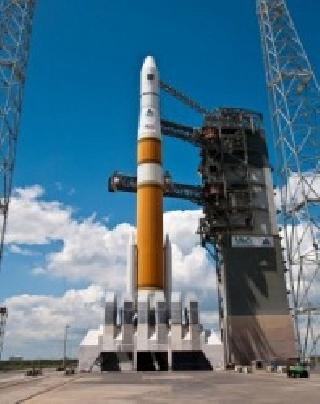
India's second mission to moon: Chandrayaan-2
BANGALORE (PTI): The payloads to be carried by India's second unmanned moon mission Chandrayaan-2 targeted for launch in 2013 were announced Monday and there will be seven onboard instruments for a range of lunar experiments.
The payloads finalised by a National Committee of Experts were announced by Indian Space Research Organisation (ISRO). Three of the seven payloads are new.
The country's prestigious maiden lunar mission Chandrayaan-1 came to an abrupt end a little less than a year after it was launched in October 2008. This mission carried 11 payloads including six from abroad.
Chandrayaan-2 spacecraft, which would have an orbiter (satellite), a lander and a rover, is planned to be launched onboard Geosynchronous Satellite Launch Vehicle (GSLV) from the Satish Dhawan Space Centre, Sriharikota in 2013.
While the lander would be provided by Russia, the orbiter and rover are being built by Bangalore-headquartered ISRO.
Chandrayaan-2 spacecraft weighs about 2,650 kg at lift-off of which the orbiter's weight is about 1,400 kg and lander about 1,250 kg.
After detailed deliberations and considering the mission needs, weight and power available for scientific payloads, the committee has recommended five payloads to be flown on the orbiter, of which three are new and two are improved versions of payloads flown earlier on Chandrayaan-1 orbiter.
The committee, drawn from ISRO centres, academic institutions and R and D laboratories and Chaired by Prof U R Rao, Chairman, Advisory Committee on Space Sciences (ADCOS) and former Chairman of ISRO, has also recommended two scientific payloads on the rover of Chandrayaan-2.
"Inclusion of additional payloads, if possible within the mission constraints, will be considered at a later date following a detailed review", ISRO said in a statement.
The five recommended payloads of Chandrayaan-2 orbiter are:
1. Large Area Soft X-ray Spectrometer (CLASS) from ISRO Satellite Centre (ISAC), Bangalore and Solar X-ray monitor (XSM) from Physical Research Laboratory (PRL), Ahmedabad for mapping major elements present on the lunar surface.
2. L and S band Synthetic Aperture Radar (SAR) from Space Applications Centre (SAC), Ahmedabad for probing the first few tens of metres of the lunar surface for the presence of different constituents, including water ice. SAR is expected to provide further evidence confirming the presence of water ice below the shadowed regions of the moon.
3. Imaging IR Spectrometer (IIRS) from SAC, Ahmedabad for mapping of lunar surface over a wide wavelength range for the study of minerals, water molecules and hydroxyl present.
4. Neutral Mass Spectrometer (ChACE-2) from Space Physics Laboratory (SPL), Thiruvananthapuram to carry out a detailed study of the lunar exosphere.
5. Terrain Mapping Camera-2 (TMC-2) from SAC, Ahmedabad for preparing a three-dimensaional map essential for studying the lunar mineralogy and geology.
The two scientific payloads on Chandrayaan-2 rover are:
1. Laser induced Breakdown Spectroscope (LIBS) from Laboratory for Electro Optic Systems (LEOS), Bangalore.
2. Alpha Particle Induced X-ray Spectroscope (APIXS) from PRL, Ahmedabad.
Both instruments are expected to carry out elemental analysis of the lunar surface near the landing site.
 Previous Article
Previous Article Next Article
Next Article













The Indian Air Force, in its flight trials evaluation report submitted before the Defence Ministry l..
view articleAn insight into the Medium Multi-Role Combat Aircraft competition...
view articleSky enthusiasts can now spot the International Space Station (ISS) commanded by Indian-American astr..
view article